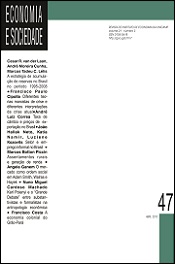Resumo
A tese deste trabalho é que as técnicas mais sofisticadas atualmente utilizadas pelos economistas para fazer previsões (métodos não estruturais de previsão, em geral, e modelos de detecção de mudanças de regime, em particular) não parecem realmente muito eficazes em prever mudanças radicais de regime como a que ocorreu na economia mundial recentemente. Assim, para aumentar seu grau de acurácia, parece razoável imaginar que tais técnicas devam ser complementadas por abordagens mais holísticas. O objetivo geral deste trabalho é mostrar que a metodologia de dinâmica de sistemas (system dynamics), que permite identificar os ciclos de feedback que comandam a dinâmica de sistemas complexos, parece estar especialmente bem-equipada para se tornar uma dessas abordagens complementares. Pretende-se, especificamente, apresentar um algoritmo sistêmico para identificar processos de mudança de regime como os que ocorrem quando uma economia, após anos de expansão continuada, sofre os efeitos da explosão de uma bolha financeira, como ocorreu recentemente.
Abstract
Identifying systemic regime shifts in economic processes: a procedure based on the system dynamics approach This paper argues that the sophisticated techniques presently used by economists to forecast macroeconomic variables behavior (non-structural forecasting methods, in general, and regimeswitching models, in particular) do not seem much effective for anticipating radical regime shifts as recently happened in the world economy. Thus, in order to improve their accuracy, it seems that they should be complemented by more holistic approaches. The general purpose of the paper is to show that the system dynamics methodology, which allows identifying the critical feedback loops that drive complex systems’ dynamics, seems to be especially fitted to be one of those complementary approaches. To reach that goal, we present a systemic algorithm which allows identifying regime shift processes as the ones that take place when an economy is hit by the effects of a financial bubble burst.
Key-words: Regime-switching models; System dynamics; Loop dominance analysis; Macroeconomics; Economic growth models.
Referências
COHEN, B. The edge of chaos: financial booms, bubbles, crashes and chaos. Chichester: John Wiley & Sons, 1997.
COYLE, R. G. System dynamics modeling: a practical approach. London: Chapman and Hall, 1996.
DIEBOLD, F. The past, present and future of macroeconomic forecasting. Journal of Economic Perspectives, v. 12, n. 2, Spring, 1998.
DIEBOLD, F; RUDEBUSCH, G. Measuring business cycles: a modern perspective. The Review of Economic and Statistics, v. 78, n. 1, 1996.
FORD, A. System dynamics and the electric power industry. System Dynamics Review, v. 13, n. 1, Spring, 1996.
FORD, D. A behavioral approach to feedback loop dominance analysis. System Dynamics Review, v. 15, n. 1, Spring, 1999.
FORRESTER, J. Urban dynamics. Waltham, MA: Pegasus Communications, 1969.
GLADWELL, M. The tipping point: how little things can make a big difference. New York: Little, Brown and Company, 2000.
HAMILTON, J. D. A new approach to the economic analysis of nonstationary time series and the business cycle. Econometrica, v. 57, n. 2, 1989.
LAVOIE, M. Introduction to post-Keynesian economics. Great Britain: Palgrave, MacMillan, 2009.
MINSKY, H. The financial instability hypothesis. In: ARESTIS, P.; SAWYER, M. (Ed.). Handbook of radical political economy. Aldershot: Edward Elgar, 1993. Disponível em: http://www.levyinstitute.org/pubs/wp74.pdf.
MINSKY, H. Stabilizing an unstable economy. New Haven and London: Yale University Press, 1986.
MINSKY, H . Can “it” happen again? New York: M.E. Sharpe, 1982.
PAICH, M. Understanding economic crisis. Isee Systems, Inc., 2010.
POTTER, S. A nonlinear approach to U.S. GNP. Journal of Applied Econometrics, 10, Apr./Jun. 1995.
RUDOLPH, J. W.; REPENNING, N. Disaster dynamics: understanding the role of quantity in organizational collapse. Administrative Science Quarterly, v. 47, n. 1, Mar. 2002.
SARGENT, T.; SIMS, C. Business cycle modeling without pretending to have too much a priori theory. In: SIMS, C. et al. New methods in business cycle research. Minneapolis: Federal Reserve Bank of Minneapolis, 1977.
SENGUPTA, N.; SWATI, S.; OSTROM, E. Sustainability, equity, and efficiency of irrigation infrastructure. In: CONSTANZA, R. Institutions, ecosystems, and sustainability. Boca Raton: Lewis Publishers, 2001.
STERMAN, J. Business dynamics. Boston: Irwin McGraw-Hill, 2000.
TAYLOR, T.; FORD, D. Tipping points failure and robustness in single development projects. System Dynamics Review, v. 22, n. 1, Spring 2006.
A Economia e Sociedade utiliza a licença do Creative Commons (CC), preservando assim, a integridade dos artigos em ambiente de acesso aberto.

